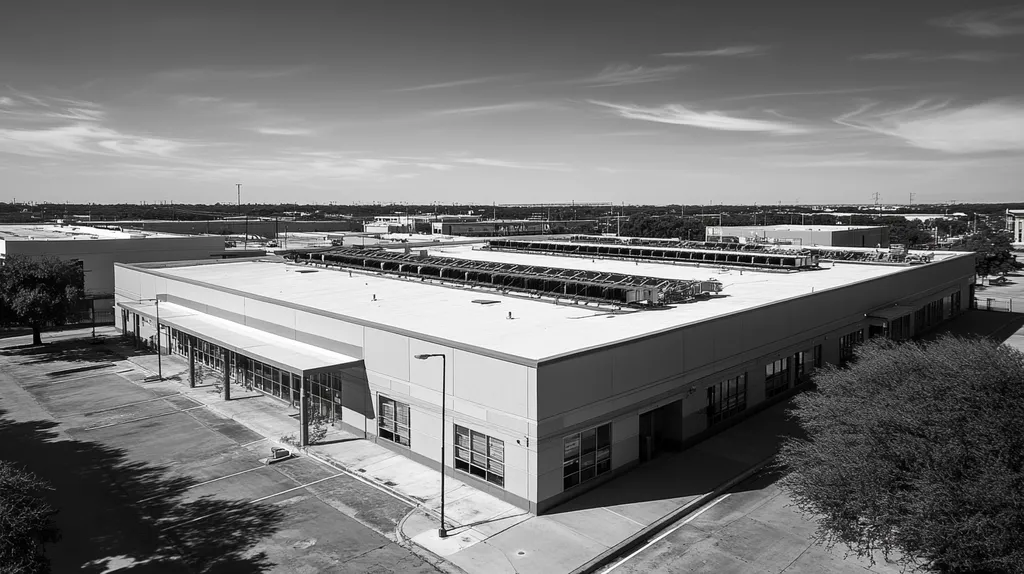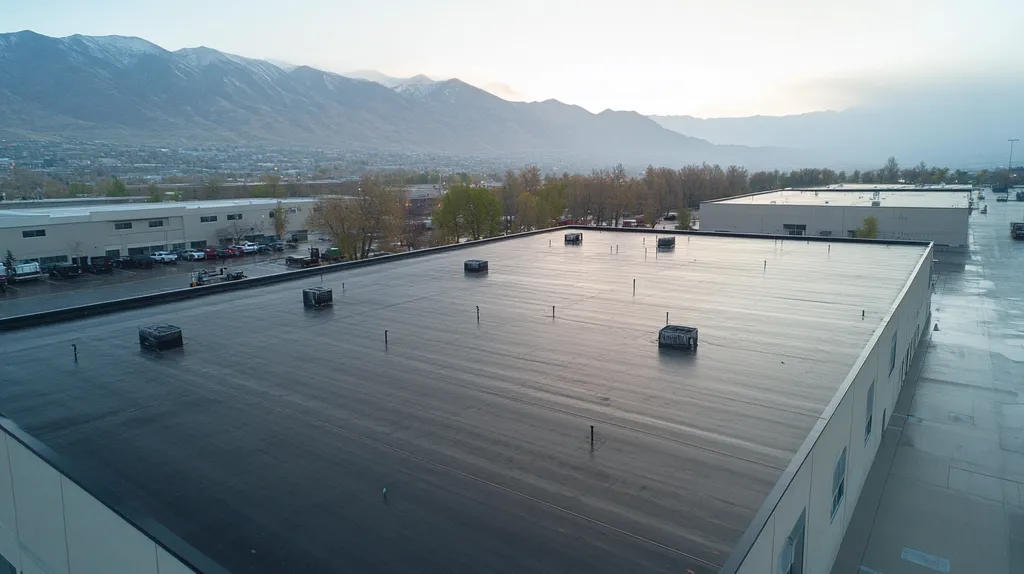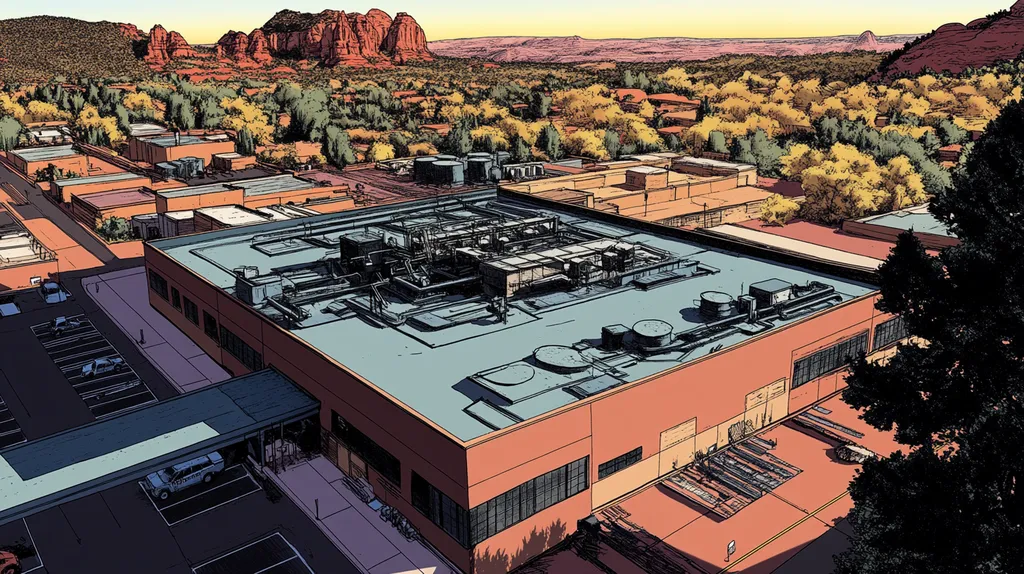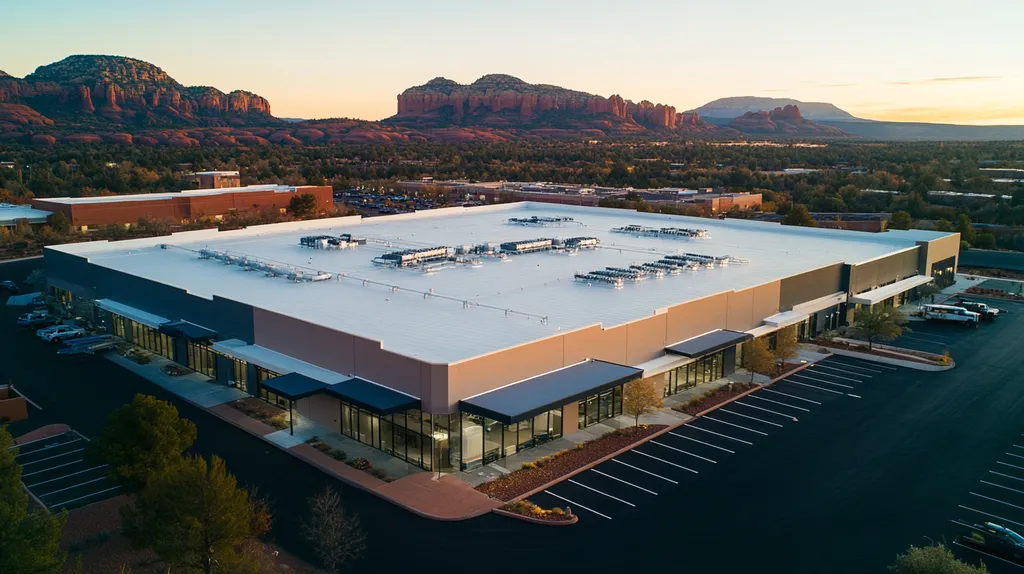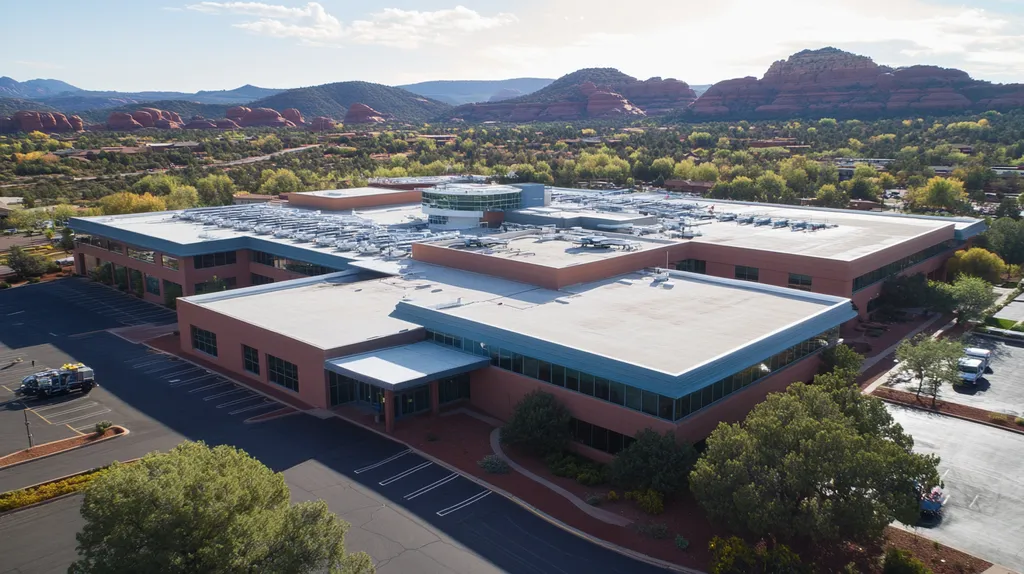In commercial roofing, weather-related delays cost the industry an estimated $3.8 billion annually, yet many property owners continue operating under dated assumptions about seasonal limitations.
From the misconception that winter repairs are impossible to misunderstandings about material capabilities, these beliefs result in postponed maintenance and escalating damage.
As modern roofing technologies evolve and climate patterns shift, facility managers must separate fact from fiction to make informed decisions about weather-related project planning.
This comprehensive analysis examines common weather delay myths, explores their practical implications, and provides evidence-based solutions for maintaining consistent project timelines throughout the year.
SECTION 1: COMMON MISCONCEPTIONS
Weather delays pose a pressing challenge in commercial roofing projects, often resulting in costly setbacks and inadequate maintenance plans. Surprisingly, nearly 30% of roofing initiatives experience interruptions due to misjudged weather capabilities. Confronting these common misconceptions is crucial for managing projects effectively and ensuring roofs remain sustainable over time.
Winter Roof Repairs Are Impossible
There’s a prevalent belief that winter roof repairs are out of the question. However, this notion is not entirely accurate. Certain materials, like modified bitumen and thermoplastic membranes, can be successfully repaired or installed even in chilly temperatures when the right techniques are used. For example, heating elements can help adhesives cure smoothly, even when the thermometer dips.
Moreover, experienced roofing contractors have a toolkit of solutions to tackle weather-related challenges. They might use specialized equipment such as heated tar kettles or adopt application methods designed for colder conditions. Failing to seize winter repair opportunities can allow minor leaks to escalate into significant problems.
In fact, addressing minor repairs during winter can significantly mitigate damage from snow and ice buildup. Facilities that recognize this can maintain their roofs’ integrity throughout the year, ultimately reducing long-term maintenance expenses.
By tackling winter repairs proactively, property owners can extend the lifespan of their roofs and avoid the pitfalls of scheduling delays rooted in unfounded seasonal assumptions.
All Roofing Materials Are Weather-Sensitive
A common misconception is that all roofing materials behave similarly under weather stress. In reality, different materials react distinctly to environmental conditions. While some may struggle in extreme temperatures and moisture, others, like metal roofs, demonstrate impressive resilience during various weather events.
Understanding the characteristics of specific materials allows for more informed decision-making. For instance, you can apply certain elastomeric coatings even in wet conditions, granting flexibility in project timelines. This knowledge equips facility managers with the insight needed to select the appropriate roofing solutions for their unique environments.
Additionally, modern roofing systems are increasingly designed to withstand a wide range of temperatures, making them viable for installation across different seasons. Embracing these advancements enables property owners to avoid unnecessary project delays rooted in misconceptions about material capabilities.
In summary, understanding roofing materials and their weather resistance empowers commercial property owners to keep projects on track without excessive interruptions.
Delaying Repairs Saves Money
Many property owners operate under the belief that postponing roof repairs will save them money. Unfortunately, this common misconception often leads to severe financial ramifications. For example, neglecting a small leak can trigger extensive interior damage, mold growth, or even structural deterioration.
Delaying repairs frequently results in more substantial costs later on. Water infiltration can damage insulation, electrical systems, and HVAC units, leading to expensive repairs. Investing in timely maintenance is a proactive strategy that helps prevent these cascading issues from developing.
Regular inspections are vital for spotting problem areas before they escalate into significant concerns. By prioritizing timely repairs, property owners can protect their investments and enhance overall roof performance.
Ultimately, prompt action regarding necessary repairs not only preserves the roof’s condition but also stabilizes the building’s overall health and longevity. This reinforces the idea that acting swiftly is a smarter financial strategy.
SECTION 2: PRACTICAL IMPLICATIONS
Weather plays a critical role in the success of commercial roofing projects, often significantly impacting timelines and quality. Research indicates that approximately 25% of roofing projects encounter delays due to adverse weather. These setbacks can lead to increased costs, prolonged exposure to damage, and unforeseen repairs that could have been avoided. It’s essential for property owners and facility managers to grasp how weather influences material performance and project scheduling.
Impact of Weather on Roofing Materials
Weather conditions can substantially alter how roofing materials perform and last. Extreme temperatures, whether icy cold or scorching hot, can compromise the adhesive qualities of membranes and the curing processes of sealants. For example, installing roofs in freezing weather may render materials brittle, increasing the likelihood of leaks down the line.
Excess moisture also poses risks, potentially leading to mold growth and deterioration of insulation. This not only affects the energy efficiency of the building but may also demand early replacement. Recognizing these impacts is vital when planning roofing work.
Selecting the appropriate materials is key to counteracting weather-related vulnerabilities. Some roofing systems are engineered to be more weather-resistant than others, and opting for these can significantly reduce risks associated with environmental stresses. Careful evaluation of material choices can yield long-term cost savings.
In summary, understanding the relationship between weather and roofing materials is essential for enhancing the durability and performance of roofs for years to come.
Scheduling Challenges in Harsh Weather
Adjusting project timelines based on weather forecasts is a critical strategy in managing roofing projects effectively. The National Roofing Contractors Association (NRCA) reports that 70% of contractors face disruptions due to unanticipated weather events. Implementing robust forecasting and contingency plans can help navigate these challenges successfully.
Project schedules should consider seasonal weather patterns. For example, roofing projects in areas with heavy rainfall should ideally be scheduled for drier months. When severe weather is predicted, pausing work can prevent complications like incomplete installations or damage from falling debris.
Clear communication with all parties involved is also essential. Property managers should keep tenants and staff updated regarding potential delays, creating realistic timelines that accommodate weather uncertainties. This level of transparency helps maintain trust even during weather disruptions.
By integrating flexible scheduling strategies, property owners can maintain operations while minimizing the adverse effects of weather-related delays.
Emergency Repair vs. Scheduled Maintenance
Unforeseen weather changes can necessitate emergency repairs, which can divert attention and resources from planned maintenance. While scheduled maintenance is crucial for pinpointing vulnerabilities before they spiraled out of control, harsh weather can impede these efforts. To avoid crisis situations, property owners should prioritize preventive maintenance measures.
Emergency repairs often come at a premium, leading to rushed jobs that may compromise quality. Scheduled maintenance, however, allows for thorough evaluations, ensuring that roofing problems are addressed systematically.
Regular inspections, regardless of weather conditions, are vital. These assessments can uncover minor issues that could escalate into larger concerns if left unaddressed.
Balancing the need for emergency repairs with proactive maintenance is essential to ensure the long-term health of a roof. Investing in scheduled maintenance not only enhances the lifespan of roofing systems but also reduces the likelihood of costly emergency situations.
SECTION 3: COST OF MISINFORMATION
The stakes surrounding misinformation about weather delays in roofing projects are alarmingly high. When repairs are postponed under misinformed assumptions, the costs for commercial properties can skyrocket. For example, a leaky roof can lead to extensive damage, with repair bills reaching upwards of $20,000 if left neglected. Property owners and facility managers must comprehend these financial implications to protect their investments and maintain operational efficiency.
Financial Consequences of Delayed Repairs
The financial burden of delaying roof repairs can be staggering. Initial issues like minor leaks may seem manageable, but they can quickly escalate into significant water damage and serious concerns over structural integrity. Not only do repair costs surge, but property owners often face lost productivity due to ongoing disruptions.
For instance, a commercial building forced to close due to severe water damage could lose thousands of dollars in revenue daily. This strain can destabilize a company’s finances long after the repair is completed. Addressing roofing issues proactively can mitigate these risks and safeguard investments.
As time passes and repairs remain unaddressed, they often require more extensive intervention. Building materials deteriorate more quickly when exposed to the elements, exacerbating the problem. This cycle of negligence leads to escalating costs that can overwhelm even the best-planned budgets.
Ultimately, the financial ramifications of misinformation regarding weather-related delays are significant. They not only increase immediate costs but can also initiate a cascade of ongoing financial challenges.
Increased Damage from Ignored Issues
Ignoring roofing issues due to misinformation can result in far-reaching damage to a commercial property. A compromised roof can permit water intrusion, leading to damaged insulation, mold growth, and deterioration of essential components. Delaying repairs only intensifies these issues, creating more extensive and costly repairs down the line.
Water penetration can also disrupt electrical systems and equipment, posing safety risks and potential operational shutdowns. As the damage accumulates, the urgency for repair increases, driving costs higher. Each ignored issue creates a ripple effect that can significantly jeopardize a property’s integrity and operational success.
Moreover, neglected roofing problems adversely affect the indoor environment. Property owners and managers must consider the negative impact on tenants and employees, which can include health issues stemming from mold and diminished air quality. Prompt action is vital for ensuring a safe and healthy building environment.
In conclusion, disregarding roof issues due to misconceptions can lead to increased damage and skyrocketing repair costs. Taking timely action is essential to avoid these devastating outcomes.
Long-Term Maintenance and Replacement Costs
Misinformation can skew perceptions regarding maintenance requirements and expected replacement schedules. Many property owners erroneously assume that weather-related delays won’t impact a roof’s long-term durability. Reality, however, reveals that neglect can considerably shorten a roof’s life span.
For instance, failing to address minor issues like leaks can necessitate a full roof replacement, which is significantly more costly than addressing small repairs in a timely manner. The financial implications can be profound, leading to replacement costs that far exceed those that would have been incurred through neglect management.
Additionally, regular maintenance becomes increasingly complicated as underlying problems multiply. An improperly maintained roof can lead to reduced energy efficiency, spiking utility costs. This extended financial strain highlights the pressing need to confront misinformation head-on.
In the end, the long-term financial consequences of misconceptions about roofing projects can far exceed any initial savings. Property owners who grasp this reality can make informed decisions that minimize both immediate and future financial burdens.
SECTION 4: REALITY CHECK
Weather delays in commercial roofing projects can wreak havoc on budgets and timelines. Research shows that such delays can inflate project costs by as much as 20%. It’s imperative for property owners and facility managers to comprehend the latest roofing techniques, adapt to seasonal variations, and account for local climate conditions. By engaging with these elements, decision-makers can better strategize roofing projects to minimize disruptions and costs.
Capabilities of Modern Roofing Techniques
Modern roofing technologies have made great strides in durability and adaptability, enabling them to withstand a variety of weather conditions. Advanced materials like TPO and PVC membranes offer enhanced resilience compared to traditional choices. These materials facilitate faster installations, thereby reducing exposure time to adverse weather.
Interestingly, specific roofing systems allow installation even in light rain. Certain adhesives and sealants can form an effective bond on damp surfaces, showcasing the advancements made in roofing technology. This knowledge empowers property owners to make informed decisions, alleviating concerns about weather interruptions.
Additionally, the adoption of innovative installation methods, like prefabricated components, can speed up project timelines. This means that, even during inclement weather, crews can continue work swiftly, minimizing downtime and the financial burden linked to weather delays.
Staying abreast of the latest roofing technologies and their capabilities is crucial. A proactive approach to selecting roofing systems can lead to a more robust strategy against weather-related disruptions.
Seasonal Adaptations for Roofing Projects
Considering seasonal factors when planning roofing projects can dramatically reduce the chances of delays. For instance, tackling roof work during dryer seasons minimizes the risk of rain or snow interference. Historical data indicates that most delays occur during winter or rainy months, underscoring the importance of strategic scheduling.
The evolution of weather forecasting tools enhances project planning significantly. By leveraging these advancements to anticipate weather conditions, roofing teams can work more efficiently. Property owners should select contractors adept at navigating seasonal weather patterns to optimize scheduling.
Moreover, establishing flexible project timelines allows teams to adapt easily to unexpected weather changes. When severe conditions are forecasted, teams can adjust schedules without jeopardizing the integrity of the project. Training team members to implement adaptive strategies further strengthens project resilience.
Seasonal considerations extend beyond timing; they also influence material selection. Choosing materials suitable for specific climate conditions can improve efficiency and reduce delays during installation. A systematic evaluation of seasonal factors can streamline roofing projects considerably.
Local Climate Considerations
Understanding the unique climate of a region is vital for successful roofing projects. Different areas present distinct weather challenges, such as heavy rains or scorching heat. For instance, in hurricane-prone regions, roofing systems must be specifically designed to endure high winds.
Property owners should analyze local climate patterns when devising their plans. Reviewing historical weather data aids in determining the best materials and scheduling, ultimately shielding projects from potential weather-related setbacks.
Engaging contractors who have expertise in local climates is also essential. These professionals can offer valuable insights into effective roofing systems tailored to prevailing conditions. Their experience can aid in making informed decisions regarding durability and waterproofing strategies.
Ultimately, prioritizing local climate considerations leads to better project outcomes. A thorough understanding of weather influences minimizes delays while enhancing the roof’s longevity and overall performance. Aligning roofing strategies with local weather patterns is a smart approach for property owners.
SECTION 5: EVIDENCE-BASED ALTERNATIVES
Weather delays can severely impact both the budget and timeline of commercial roofing projects. Alarmingly, nearly 40% of roofing jobs face setbacks due to adverse weather conditions. Fortunately, there are effective strategies available to counter these challenges. This section delves into the use of specialized adhesives designed for cold weather, highlights the advantages of metal roofing as a winter-friendly option, and underscores the importance of flexible scheduling with local contractors.
Using Specialized Adhesives in Cold Weather
Cold weather creates unique challenges for roofing installations, particularly in adhesion. Conventional adhesives may falter in frigid temperatures, which can jeopardize the roof’s structural integrity. To counter this, specialized cold-weather adhesives have been developed to maintain exceptional bonding even at low temperatures.
These innovative adhesives are often formulated with unique polymers that enhance flexibility and durability. Remarkably, some products can cure effectively at temperatures as low as 20 degrees Fahrenheit, enabling contractors to proceed with installations when traditional methods fall short.
By incorporating these advanced adhesives, property owners can reduce downtime while ensuring the roof system remains robust against seasonal challenges. This proactive strategy not only helps meet project deadlines but also extends the roof’s overall lifespan.
Metal Roofing as a Winter-Friendly Option
Metal roofing stands out as a highly effective solution for winter roofing projects. Unlike traditional materials, metal roofs are quick to install and are considerably less prone to water infiltration—a crucial factor during rain or snowstorms that can disrupt timelines.
Additionally, many metal roofing systems are engineered for straightforward installation, even under cold or wet conditions. For instance, standing seam metal roofs can be secured without penetrating the underlying deck, drastically reducing the risk of leaks and moisture penetration.
The inherent properties of metal roofs also enhance energy efficiency, reflecting heat during warmer months while providing insulation in winter. This dual functionality appeals to property owners keen on maximizing their return on investment.
Choosing metal roofing not only helps avert weather-related delays but also protects roofs from potential damage due to prolonged adverse conditions. Strategic selection of roofing materials can lead to smoother projects and enduring results.
Flexible Scheduling with Local Roofers
Implementing a flexible scheduling system with local roofing contractors can greatly reduce the impact of weather-related setbacks. Local expertise allows contractors to better understand regional climate trends and adjust their work schedules accordingly. This adaptability facilitates real-time project management in response to changing weather conditions.
With on-the-ground knowledge, roofing teams can dynamically allocate their resources, responding swiftly when conditions become favorable. This agility minimizes downtime and helps maintain momentum, even amidst unpredictable weather patterns.
Moreover, working with local roofers ensures quicker response times. When immediate adjustments are necessary, having a nearby team can be the difference between timely project completion and significant delays.
Ultimately, investing in local expertise and embracing flexible scheduling cultivates a more resilient roofing operation. By planning thoughtfully, facility managers can better navigate unexpected weather challenges, leading to successful project outcomes.
SECTION 6: TEST AND VERIFY
Weather-related delays can dramatically derail commercial roofing projects, leading not only to inflated costs but also extending timelines unnecessarily. A 2021 study highlighted that weather concerns alone account for an average of 20% of total project delays across the construction industry. To mitigate these impacts, property owners and facility managers must prioritize effective testing and verification strategies throughout the roofing process. This includes conducting regular roof inspections, closely monitoring weather forecasts, and establishing robust final inspection procedures.
Conducting Regular Roof Inspections
Conducting regular roof inspections is essential for identifying potential issues before they escalate into costly weather-related delays. Scheduled assessments allow roofing professionals to pinpoint problems like leaks, membrane wear, or debris accumulation. For commercial roofs, inspecting at least twice a year—ideally in spring and fall—aligns with seasonal weather changes and helps maintain roof integrity.
An inspection regimen ensures optimal roof condition, reducing the chances of last-minute repairs during inclement weather. It’s also crucial to monitor the roof’s performance after severe storms or extreme temperatures to assess its resilience. Utilizing techniques such as infrared thermography can uncover hidden moisture, making it a vital tool for evaluating roof integrity.
Implementing a documented inspection protocol establishes a baseline for future evaluations. This data-driven approach enables facility managers to track roof performance over time and make informed maintenance and upgrade decisions. Regular inspections not only enhance immediate safety but also contribute significantly to long-term cost efficiency.
In conclusion, proactive roof inspections significantly mitigate the impact of weather-related delays and foster a more reliable project schedule.
Monitoring Weather Forecasts for Delays
Staying ahead of weather conditions is crucial for effective roofing timeline management. Advanced forecasting tools allow facility managers to predict delays due to storms, strong winds, or extreme temperatures. By incorporating weather monitoring into project planning, teams can adapt schedules and workflows proactively.
For example, if a heavy rain warning is issued, site managers can secure materials or reschedule sensitive tasks. Communication is key—team members should receive timely updates on forecasts to prevent wasted labor and resources. It’s vital that information flows seamlessly from project managers to roofing crews to ensure everyone understands potential adjustments based on predicted weather scenarios.
Leveraging mobile applications or specialized weather services enhances access to crucial data. These resources provide real-time updates necessary for making timely decisions, encouraging a proactive rather than reactive approach to unforeseen weather events. Building relationships with local meteorological services can also offer insights tailored to specific project locations, aiding in strategic planning.
Final Inspection and Adjustment Procedures
The final inspection stage is critical for confirming that a roofing project can endure future weather conditions. A thorough assessment should occur once major roofing work concludes, focusing on sealing, insulation, and drainage systems to ensure optimal performance.
During this phase, any deficiencies identified must be addressed immediately. Taking care of minor adjustments can significantly enhance a roof’s ability to withstand heavy precipitation or snowfall. By confirming that all materials are correctly installed and finished, property owners can prevent costly repairs in the future.
Documentation of the final inspection is not only beneficial for warranties but also essential for future maintenance planning. This record serves as a reference point should issues arise throughout the roof’s lifecycle and demonstrates compliance with industry standards.
Fostering a culture of communication among all stakeholders during this phase promotes thoroughness and attention to detail. Emphasizing the significance of final inspections lays the groundwork for ongoing roof maintenance, resulting in greater long-term resilience against weather delays.
Moving Forward
Weather-related delays cost the commercial roofing industry billions annually, yet technological advances and strategic planning can dramatically reduce their impact.
The reality is that nearly 40% of roofing projects face weather setbacks, but modern materials like specialized cold-weather adhesives and metal roofing systems now enable year-round installations.
Property owners who embrace evidence-based strategies, including flexible scheduling and proactive maintenance, can reduce delays by up to 60% while extending roof lifespans.
The evolution from traditional built-up roofing to advanced synthetic systems demonstrates how far the industry has progressed in weather resilience.
As climate patterns become increasingly unpredictable, separating roofing fact from fiction isn’t just about cost savings—it’s about ensuring the long-term sustainability of commercial properties.
FREQUENTLY ASKED QUESTIONS
Q. Are winter repairs on commercial roofs feasible?
A. Contrary to popular belief, winter repairs can be done using specific materials and techniques. For example, certain adhesives can effectively cure in cold temperatures. Proactively addressing minor issues in winter can prevent more costly problems down the line, ultimately enhancing the roof’s longevity.
Q. How does weather affect scheduling for commercial roofs?
A. Weather significantly impacts scheduling, with about 70% of contractors reporting disruptions due to unexpected conditions. Adjusting project timelines based on forecasts is essential. Effective communication of schedule changes helps maintain trust and ensures everyone is informed of potential delays.
Q. What are the costs of delaying repairs for commercial roofs?
A. Delaying repairs can lead to escalating costs and extensive damage. For instance, a small leak can lead to significant structural issues and lost productivity. Addressing roofing problems promptly not only mitigates immediate financial impacts but protects investments over time.
Q. How do modern roofing techniques handle weather?
A. Modern roofing techniques utilize advanced materials that enhance durability against various weather conditions. For example, PVC membranes perform well in adverse conditions and can expedite installations. Understanding these techniques allows property owners to minimize disruptions during projects.
Q. Can specific adhesives improve cold-weather roofing projects?
A. Yes, specialized cold-weather adhesives maintain strong bonds in low temperatures, facilitating installations even during winter. These products enhance project efficiency and roof durability, reducing the downtime associated with adverse weather conditions.
Q. What role do local contractors play in roofing project success?
A. Local contractors understand regional climate nuances and can adapt project schedules quickly. Their expertise allows for real-time management of tasks, minimizing delays. Collaboration with local teams ensures better responsiveness and enhances project outcomes, especially during unpredictable weather changes.
Q. How often should I schedule roof inspections?
A. Conducting roof inspections at least twice a year—ideally in spring and fall—is recommended. Regular assessments help identify potential issues before they escalate, reducing the likelihood of costly repairs and ensuring the roof’s integrity against weather challenges.

